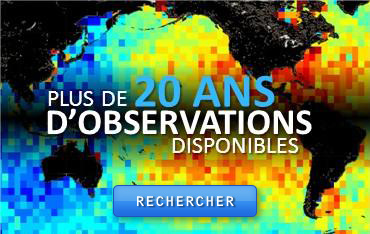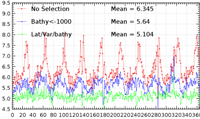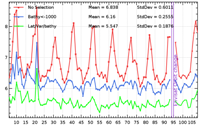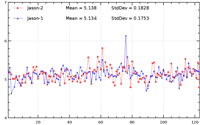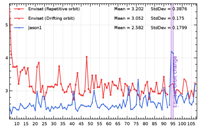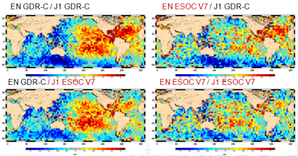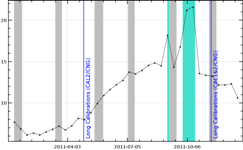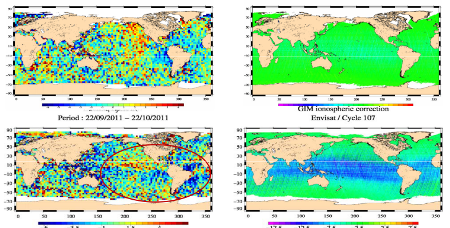GDR 2011 validation
The validation activities performed on Jason-1, Jason-2 and Envisat GDR 2011 data are synthesized in 3 reports (see systematic validation web page). They assess the altimeter data quality: missing and edited measurements, relevant parameters derived from instrumental measurements and geophysical corrections. Analyses are also focused on cross-calibration to precisely assess parameter discrepancies between missions in order to detect geographically correlated biases, jumps or drifts.
For the first time this year, all the Geophysical Data Record (GDR) Envisat products were reprocessed on the whole time series. The comparison between the previous GDR data set and the new one (so called V2.1 GDR version) are detailed in a dedicated document (see dedicated Envisat reprocessing web page).
In year 2011, we pointed out particularly that:
Performances at crossovers
Studies on new orbits
Studies on orbit standards were also carried on to test the preliminary GDR-D standards (from CNES and ESOC POD centers).
They showed that the East West discrepancies could be efficiently reduced thanks to a new Time Variable Gravity field considered in the POE solution.
In preparation of the Jason-2 reprocessing in GDR-D standard (which takes place during 2012), preliminary GDR-D orbit standard and 8 Jason-2 cycles in preliminary GDR-D version were already available for 2011 OSTST meeting (on project level). Some analysis of these standards are available in the Jason-2 annual validation report of 2011.
Fuel depletion manoeuvers on Jason-1
In September and October 2011 (during cycles 356, 358, 359, and 360) fuel depletion maneuvers (inclination maneuvers) were done for Jason-1. During these cycles, more measurements than usual are edited. During this fuel depletion campaign, precise orbit determination was computed, but it was quite difficult for these cycles which needed a dedicated processing. Though this special POE processing often gave better results than MOE processing (orbit available in the IGDR product), it is advised to use the orb_state_flag in order to invalidate POE estimated during maneuver periods.
Wet troposphere correction for Jason-1 and Jason-2
As the wet troposphere correction is a very important variable for mean sea level trend calculation, radiometer - ECMWF model wet troposphere correction differences are continously monitored. For Jason-1, the radiometer - model wet troposphere difference is strongly impacted by the yaw maneuvers. This impact seems to get stronger over time.
The Jason-2 radiometer wet troposphere correction is not impacted by the yaw maneuvers. But it is subject (for IGDR data) to drifts and jumps. Thanks to the ARCS system, these problems are mostly corrected in GDR. Nevertheless small jumps persist. There are also small drifts visible within a cycle (for exemple cycle 111 and 112), as the ARCS corrections apply a discret value to correct a drift.
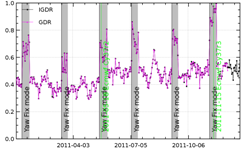
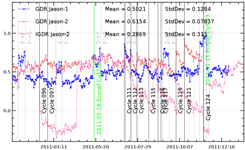
Ionospheric correction for Envisat
Still, a slight degradation of the data was identified due to the recent increase of the solar activity: Since the loss of the S-Band at the beginning of year 2008, the solar activity was in a low period, therefore the use of the JPL-GIM model correction instead of the dual-frequency correction in the SSH equation was efficient and, data were weakly impacted in terms of variance. In 2011 the solar activity started to increase again and the degradation due to this correction is getting significant.
The degradation of the iono GIM-Bifrequency on Envisat data is starting to be visible on the statistics at crossovers on which a signal starts to appear (mostly in the atlantic).
Note that the phenomenon is amplified at crossovers due to the strong diurnal signal on iono correction and sun-synchronism of the mission.
Further information:
- Annual reports
- Jason-2 2011 annual validation report (June 2012) (pdf 16 Mb)
- Jason-1 2011 annual validation report (June 2012) (pdf, 22 Mb)
- Envisat 2011 annual validation report (June 2012) (pdf, 13 Mb)
